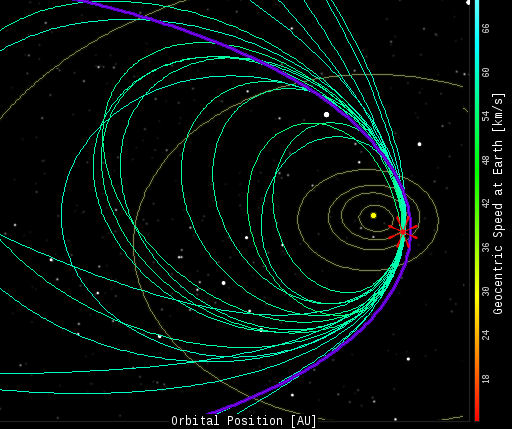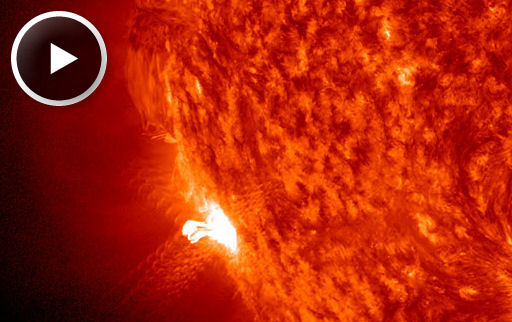CURIOSITY'S FIRST DAREDEVIL STUNT: When Curiosity enters the Martian atmosphere on August 6th, setting in motion "the seven minutes of terror" that people are buzzing about, the rover will actually be performing the mission's second daredevil stunt. The first, involving solar flares, was completed in July. [full story]
EARLY PERSEID METEORS: Earth is entering a broad stream of debris from Comet Swift-Tuttle, source of the annual Perseid meteor shower. Meteoroids in the outskirts of the stream are now hitting Earth's atmosphere, producing as many as 10-15 meteors per hour according to worldwide counts from the International Meteor Organization. NASA's network of all-sky meteor cameras captured 17 Perseid fireballs on the nights of July 28th through 30th. Here are their orbits:
The position of Earth is denoted by the red starburst; all of the meteoroid orbits intersect at that point. The purple line traces the orbit of the parent Comet Swift-Tuttle. Fortunately, the comet itself does not intersect Earth.
In the days ahead, Earth will plunge deeper into the meteoroid stream, and meteor rates will increase accordingly. Forecasters expect the shower to peak on August 12-13 with as many as 100+ meteors per hour visible from dark-sky sites. Monitor the realtime meteor gallery for sightings.
CRACKLING SUNSPOT: Newly-numberd sunspot AR1538 is small but active. In an 18-hour period on July 30-31, it popped off more than 15 minor flares. Watch the sunspot crackle in this movie from NASA's Solar Dynamics Observatory:
The nearly-constant flaring is a sign of tension in the sunspot's magnetic field. It is not, however, a sure-fire sign that a major eruption is in the offing. On the contrary, a large number of minor flares might provide a degree of "magnetic relief" that makes a major eruption less likely.
The most likely source of a major flare today is sunspot AR1535, located more than 400,000 km north of crackling sunspot AR1538. AR1535 is relatively quiet but has a beta-gamma magnetic field that harbors energy for strong M-class eruptions.Solar flare alerts: text, voice.

![]()
Solar wind
speed: 434.0 km/sec
density: 1.6 protons/cm3
explanation | more data
Updated: Today at 1427 UT
![]()
X-ray Solar Flares
6-hr max: C1 1314 UT Aug02
24-hr: C1 1314 UT Aug02
explanation | more data
Updated: Today at: 1400 UT
![]()
![]()
![]()
Daily Sun: 01 Aug 12
![]()
![]()
Sunspot AR1535 has a 'beta-gamma' magnetic field that harbors energy for M-class solar flares. Credit: SDO/HMI
![]()
![]()
![]()
Sunspot number: 118
What is the sunspot number?
Updated 01 Aug 2012
Spotless Days
Current Stretch: 0 days
2012 total: 0 days (0%)
2011 total: 2 days (<1%)
2010 total: 51 days (14%)
2009 total: 260 days (71%)
Since 2004: 821 days
Typical Solar Min: 486 days
Updated 01 Aug 2012
The Radio Sun
10.7 cm flux: 136 sfu
explanation | more data
Updated 01 Aug 2012
![]()
![]()
![]()
Current Auroral Oval:
![]()
Switch to: Europe, USA, New Zealand, Antarctica
Credit: NOAA/POES
![]()
![]()
![]()
Planetary K-index
Now: Kp= 2 quiet
24-hr max: Kp= 2 quiet
explanation | more data
![]()
Interplanetary Mag. Field
Btotal: 13.7 nT
Bz: 13.6 nT north
explanation | more data
Updated: Today at 1426 UT
![]()
![]()
![]()
Coronal Holes: 01 Aug 12
![]()
![]()
There are no large coronal holes on the Earthside of the sun. Credit: SDO/AIA.






